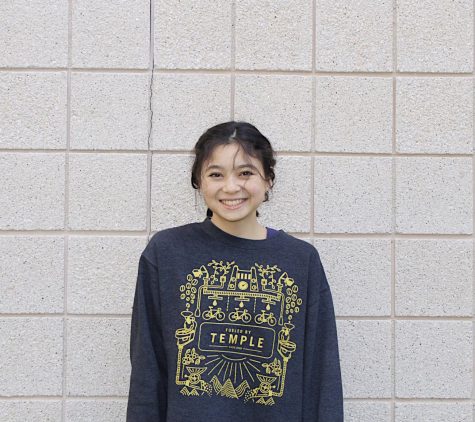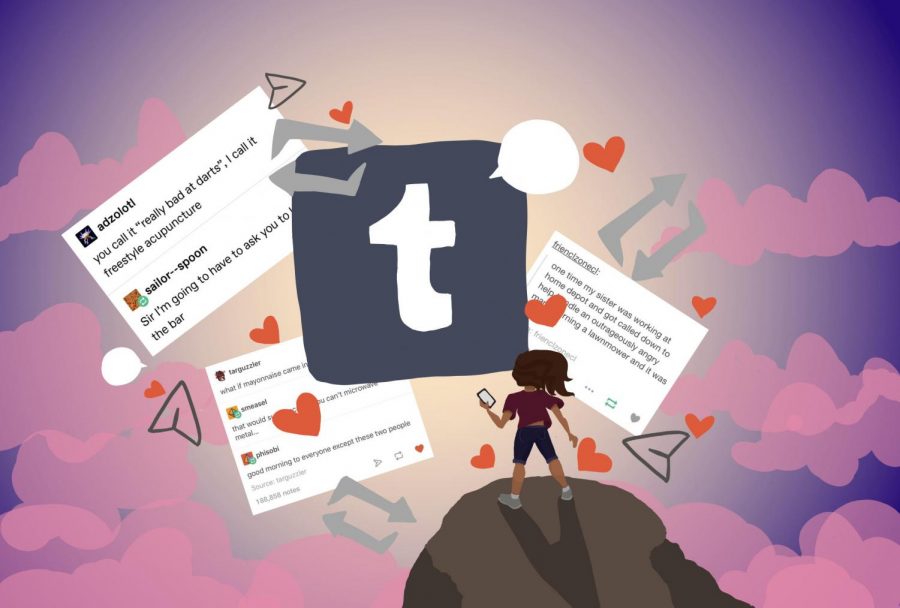Wild, Wacky, and Wonderful: The Creation of Tumblr Culture
Unlike most others my age, I’ve never been one for social media. The combination of influencer culture, lack of privacy, and the internalization of “stranger danger” effectively kept me off Snapchat, Instagram, and now TikTok. Yet Tumblr, with its wacky humor and vibrant GIFs and filter-less people, seduced my social media-hating self.
I’m not the only one; since 2007 Tumblr has drawn in 472 million people and boasts an impressive engagement rate. The unique mechanics of Tumblr (asks, reblogs, etc.) have yielded a distinctive social media culture that’s worth a closer look.
While many apps have similar features (think Instagram’s “Stories” vs. Snapchat’s “Story” format), small differences can have sweeping effects on a social media culture. In Tumblr’s case, this is seen through their reblogs and Twitter’s retweets. A retweet is when ‘Account A’ displays a post from ‘Account B’ on ‘A.’ Reblogs work similarly, with one key difference. Reblogs may contain not just the original post, but also some of the comments as well. This causes comments on Tumblr to have a wider viewership than comments on Twitter. Here lies the first distinction between Tumblr and others.
If you have ever perused Tumblr, you will eventually find something called a “heritage post.” While there is no strict definition of a heritage post, it can be recognized by a high number of notes (likes, reblogs, and comments), its enduringness, and the number of people who comment “I’ve only ever seen this in screenshots!” Heritage posts are so omnipresent that there are multiple blogs on Tumblr that are dedicated to preserving them. The reason why Tumblr has heritage posts while other sites do not is that Tumblr has those aforementioned reblogs.
Heritage posts often become so because they are made continuously funnier by the added comments. These added comments are then often seen with the original post. The heritage post is less a singular post and more an original post with 10 funnier comments beneath it. This kind of post plus comments isn’t seen on other sites, such as Twitter, because you can’t retweet the original post and the comments. Research shows that on average Tumblr posts have a much longer engagement life than posts on other sites. Because of the reblog function, Tumblr developed a culture known for its long-lasting, famous posts.
Perhaps the biggest difference between Tumblr and other social media sites is the lack of influencers. This dearth of Twitter tastemakers, TikTok trendsetters, and impactful Instagrammers on Tumblr has been caused by the absence of the blue check. Although certain companies might have slightly different rules on who gets bestowed the blue check crown, the basics are that the account must belong to someone who is notable in some way. The existence of the blue check does one incredibly important thing to a social media site’s culture: it creates a hierarchy of bloggers, with influencers on top. So, what happens when there isn’t a blue checkmark?
While it may appear otherwise, blue checkmarks serve more purposes than just to look pretty. A blue checkmark promises exclusiveness and verifiability. A blue checkmark also bequests the account an incredibly valuable power: algorithm priority. Algorithm priority means that when you search for a name, a hashtag, or who to follow the blue checkmarks come up first. If Twitter, Instagram, and TikTok were kingdoms, then blue checkmarks would be the gorged Lords and Ladies while the checkless would be the starving peasants.
Unlike the other social media sites Tumblr is not a monarchy, but rather a lawless anarchist society. On Tumblr, there is no way to tell if the potato blog, in which someone roleplays as a potato, has 10 followers or 100,000 followers. A perverse equality is created in Tumblr culture because there is no way to know who is famous. The absence of the blue check has caused Tumblr to have a rather plebeian culture, with nary a Charli D’amelio or Kylie Jenner in sight.
Though not limited to Tumblr, it has still become known for its anti-FOMO culture, in which depression and anxiety are an aesthetic or an enviable lifestyle. People on Tumblr often romanticize mental illness in much the same way that Instagramers romanticize unachievable body types. While the reason why this strange culture phenomenon appears most on Tumblr can only be hypothesized, I believe that it likely came out of Tumblr’s anonymous nature.
Compared to other social media sites, Tumblr is largely anonymous with a first name often being the most private information given. This anonymity allows people to express themselves freely. After all, there’s a big difference between having your struggles with depression public for the whole world to see versus hidden behind a wacky username. Though this anti-FOMO culture exists on other social media platforms, it became synonymous with Tumblr and popular on Tumblr because the anonymity paved the way for the emo takeover of Tumblr.
Perhaps the biggest, most defining piece of Tumblr has been fandom culture. Tumblr, a website not geared towards fandom, has similar numbers of fandom participants as Archive of Our Own, a literal fan-fiction site. While there are likely several sources of the predominance of fandom on Tumblr (such as the fallout caused by the demise of LiveJournal, a previous fandom site), the two most important is the lack of a word limit on posts and the lenient policy on pornography (until 2018).
The lack of a word limit meant that fan-fiction could actually be posted on Tumblr. For example, if you wanted to post a 3,000 word Harry Potter fan-fiction, would you post it on Twitter, where you would have to cut it up into a thread, on Instagram, where you would have to take a picture of it, or on Tumblr, where you can have a singular post house the whole fan-fiction. The answer is clear to you, and it has been clear to fandom Tumblr since its boom in the 2010s.
The second cause of Tumblr fandom culture was the allowance of pornography. Before 2007, the majority of fandom resided on LiveJournal, but the deletion of several journals, in what would come to be called Strikethrough, along with several unpopular changes caused fandom to start looking for a new home.
In contrast to LiveJournals deletions, Tumblr was very lenient when it came to NSFW (Not Safe For Work) material, stating that “we [Tumblr] have no problem with that kind of stuff. Go nuts. Show nuts. Whatever” in their terms of service. While not all of Tumblr is explicit, a good portion of it is, meaning that Tumblr’s “whatever” attitude toward pornography helped fandom to explode on the site. The ability to easily post (sometimes) explicit fan-fiction has led Tumblr culture to be defined by its fandoms.
Fandom and LGBTQ people go together like Captain America and Bucky Barnes. LGBTQ communities flourished on Tumblr mainly because of anonymity and lack of porn bans. Jamie from Ontario told Out that she wouldn’t have been able to “[look] up LGBTQ content on Instagram and Twitter for fear of outing [herself] or being outed.” Anonymity meant that LGBTQ people could be themselves online.
The other main reason why Tumblr has been dubbed a “queer utopia” is because of Tumblr’s previous “Go nuts. Show nuts” mentality. Porn bans often aren’t created equally because LGBTQ sexuality is viewed as inherently more inappropriate than heterosexuality. Where other social media sites’ stringent porn bans, and lack of anonymity, would push LGBTQ people out, Tumblr, in all its cool-older-brother glory, welcomed LGBTQ people in.
Last, but never least, Tumblr’s Social Justice community has become a defining feature of the app with 64% of users saying that they “care about social causes and look into them on Tumblr.” This community of social justice bloggers came about because of Tumblr’s ask function, the tagging system, and most importantly, the lack of word limits.
Asks and tagging both lent ease to the growth of social justice on Tumblr. “Asks” mean that if someone has a social justice-related question, they can ask it easily and anonymously. The “tagging” feature meant that finding social-justice-related posts was quick. On Twitter, for example, people mostly search for things through keyword searches. One could write a whole post on Twitter about racial inequalities in prison without explicitly saying “social justice” in the whole post.
As a result, that post would not appear if one searched for “social justice.” It’s simply easier to exist as a social justice blogger on Tumblr than on other social media sites. Finally, the lack of word limits on Tumblr has allowed social justice to thrive on the app. It is impossible to write a comprehensive post on transphobia in sports in 280 letters. You can’t write a social justice essay on Twitter but you can on Tumblr. Asks, tagging, and lack of word limits thus spawned a much-loved, and much-loathed, social justice culture on Tumblr.
A heritage post museum, an influencer wasteland, a pro-depression group therapy, Fandom, an LGBTQ paradise, or a social justice haven are all appropriate names for Tumblr. This strange, miraculous website has been formed by its asks, reblogs, and other unique functions. The website brought together so-called social justice warriors, LBGTQ youth, stan fans, and memers all under one roof. Wild, wacky, and wonderful: it’s one hell of a culture.

Jadyn has somehow survived 3 years of high school to become a senior. When not editing opinion articles, Jadyn can either be found stumping for Certamen...

Carmen, a senior this year, is excited to continue helping out with the banner. Outside of school, she enjoys art, sleeping, and going on walks. She claims...


